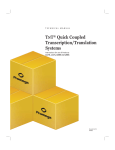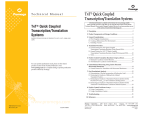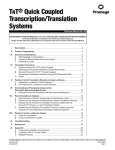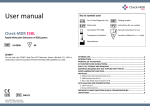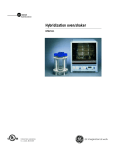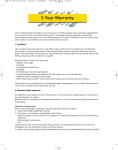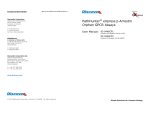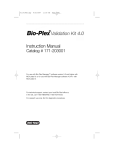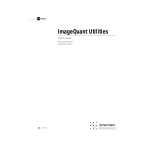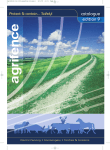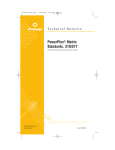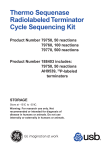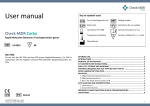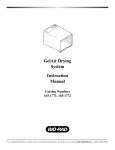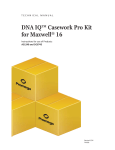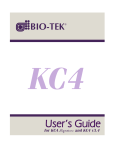Download Promega Quick Coupled TNT Manual
Transcript
tm045.0505.qxp 7/6/2005 9:39 AM Page 1 Technical Manual TNT® Quick Coupled Transcription/Translation Systems INSTRUCTIONS FOR USE OF PRODUCTS L1170, L1171, L2080 AND L2081. For your protein purification needs, please see the related products section of this Technical Manual or visit www.promega.com for a complete listing of protein purification products offered by Promega. PRINTED IN USA. Revised 5/05 Part# TM045 A F 9 T M0 4 5 0 5 0 5 T M0 4 5 tm045.0505.qxp 7/6/2005 9:39 AM Page 1 TNT® Quick Coupled Transcription/Translation Systems All technical literature is available on the Internet at www.promega.com/tbs Please visit the web site to verify that you are using the most current version of this Technical Manual. Please contact Promega Technical Services if you have questions on use of this system. E-mail [email protected]. I. Description..........................................................................................................2 II. Product Components.........................................................................................5 III. General Considerations....................................................................................6 A. DNA Template Considerations..........................................................................6 B. Creating a Ribonuclease-Free Environment.....................................................8 C. Handling of Lysate...............................................................................................8 IV. Translation Procedure.......................................................................................8 A. General Protocol for TNT® Quick Coupled Transcription/Translation Reactions Using Plasmid DNA...........................9 B. General Protocol for TNT® T7 Quick Coupled Transcription/Translation Reactions Using PCR-Generated DNA ...........10 C. Notes.....................................................................................................................11 V. Positive Control Translation Reactions Using Luciferase.......................13 A. Radioactive Luciferase Control Reaction........................................................13 B. Non-Radioactive Luciferase Control Reaction...............................................13 VI. Cotranslational Processing Using Canine Pancreatic Microsomal Membranes.................................................................................14 A. General Protocol for Translation with Microsomal Membranes ................14 VII. Post-Translational Analysis...........................................................................15 A. Determination of Percent Incorporation of Radioactive Label ...................15 B. Denaturing Gel Analysis of Radioactively Labeled Translation Products..........................................................................................16 C. Denaturing Gel Analysis of Translation Products Labeled with the FluoroTect™ GreenLys in vitro Translation Labeling System......................18 D. Denaturing Gel Analysis of Translation Products Labeled with the Transcend™ Non-Radioactive Translation Detection Systems...................19 VIII. Positive Control Luciferase Assays..............................................................20 A. Using a Luminometer ........................................................................................20 B. Using a Scintillation Counter............................................................................20 IX. Troubleshooting...............................................................................................21 X. References .........................................................................................................23 Promega Corporation · 2800 Woods Hollow Road · Madison, WI 53711-5399 USA Toll Free in USA 800-356-9526 · Phone 608-274-4330 · Fax 608-277-2516 · www.promega.com Printed in USA. Revised 5/05 Part# TM045 Page 1 tm045.0505.qxp 7/6/2005 9:39 AM Page 2 XI. Appendix ...........................................................................................................25 A. Composition of Buffers and Solutions ............................................................25 B. Luciferase SP6/T7 Control DNAs ...................................................................26 C. Related Products.................................................................................................27 I. Description The TNT® Quick Coupled Transcription/Translation Systems(a–e) are convenient single-tube, coupled transcription/translation reactions for eukaryotic in vitro translation. The original TNT® Coupled Reticulocyte Lysate Systems(a,b,d,e) simplified the process and reduced the time required to obtain in vitro translation results compared with standard rabbit reticulocyte lysate systems (1). Standard rabbit reticulocyte systems commonly use RNA synthesized in vitro from SP6, T3 or T7 RNA polymerase (1). The TNT® Quick Coupled Transcription/Translation System further simplifies the process by combining the RNA polymerase, nucleotides, salts and Recombinant RNasin® Ribonuclease Inhibitor(b,c) with the reticulocyte lysate solution to form a single TNT® Quick Master Mix (Figure 1). For most gene constructs, the TNT® Quick reaction produces significantly more protein (two- to sixfold) in a 60- to 90-minute reaction than a standard in vitro rabbit reticulocyte lysate reaction using RNA templates. The TNT® Quick Coupled Transcription/Translation System is available in two configurations for transcription and translation of genes cloned downstream from either the T7 or SP6 RNA polymerase promoters. To use these systems, 0.2–2.0µg of circular plasmid DNA containing a T7 or SP6 promoter, or a PCR(f)generated fragment containing a T7 promoter, is added to an aliquot of the TNT® Quick Master Mix and incubated in a 50µl reaction volume for 60–90 minutes at 30°C. The synthesized proteins are then analyzed by SDS-polyacrylamide gel electrophoresis (SDS-PAGE) and detected. Included with the TNT® Quick System is a luciferase-encoding control plasmid and Luciferase Assay Reagent(a,e,g), which can be used in a non-radioactive assay for rapid (<30 seconds) detection of functionally active luciferase protein. Starting with either circular plasmid DNA or PCR-generated DNA, in vitro transcription/translation results may be obtained easily in 5–6 hours. ! PCR-generated fragments are not recommended for use with the SP6 promoter. Use the T7 promoter. Promega Corporation · 2800 Woods Hollow Road · Madison, WI 53711-5399 USA Toll Free in USA 800-356-9526 · Phone 608-274-4330 · Fax 608-277-2516 · www.promega.com Part# TM045 Page 2 Printed in USA. Revised 5/05 tm045.0505.qxp 7/6/2005 9:39 AM Page 3 TNT® Coupled Reticulocyte Lysate System TNT® Rabbit Reticulocyte Lysate. TNT® Quick Coupled Transcription/Translation System Add TNT® Reaction Buffer. TNT® Quick Master Mix. Add TNT® RNA Polymerase. Add Amino Acid Mixture Minus Methionine. Add RNasin® Ribonuclease Inhibitor. Add label of choice. Add DNA template and Nuclease-Free Water. Separate translation products by SDS-PAGE. Detect 1537MB11_2A Incubate at 30°C for 60-90 minutes. Figure 1. Comparison of the TNT® Coupled Reticulocyte Lysate System and the TNT® Quick Coupled Transcription/Translation System protocols. Promega Corporation · 2800 Woods Hollow Road · Madison, WI 53711-5399 USA Toll Free in USA 800-356-9526 · Phone 608-274-4330 · Fax 608-277-2516 · www.promega.com Printed in USA. Revised 5/05 Part# TM045 Page 3 tm045.0505.qxp 7/6/2005 9:39 AM Page 4 In addition to verifying the expected molecular weight of a gene construct, the TNT® Quick System is ideal for screening large numbers of constructs for either naturally occurring or deliberately engineered mutations. Applications of the system include: • • • • • • • Truncation mutation analysis [e.g., the Protein Truncation Test (PTT)] (2) Drug screening (affecting translation rates) Mutation and detection analysis (i.e., enzyme kinetics) Protein:protein interactions (using GST pulldowns) Immunoprecipitation of protein complexes Protein dimerization assays Ligand-binding region determination/confirmation/ competition assays • • • • • • • In vitro expression cloning (IVEC) (functional genomics) Protein structure analysis Electrophoretic mobility shift assays (EMSAs) for DNA:protein interactions DNA footprinting and protein cross-linking studies Protein-RNA binding assays Post-translational modification tests Verification/characterization of cloned genes The TNT® Quick Coupled Transcription/Translation Systems are also useful for detecting protein:protein interactions in vitro. [35S]methionine-labeled proteins labeled using TNT® Quick Coupled Transcription/Translation System can be used as probes to detect interactions with suspected protein partners that have been expressed as GST-(glutathione-S-transferase) or epitope-tagged fusion proteins (3). [35S]methionine-labeled proteins can be synthesized using coupled in vitro reactions from either full-length cDNAs or deletion mutants. The fusion proteins can be bound to an affinity matrix along with the radioactive proteins with which they interact (4–6). The bound radioactive proteins are then eluted and analyzed by SDS-PAGE or Western analysis (Figure 2; 6). The fusion tag approach has been used to study receptor-mediated control of apoptosis (7). Alternatively, a non-radioactive approach may be used; the protein is labeled with biotinylated lysine (e.g., Transcend™ Biotinylated tRNA) or is fluorescently tagged (e.g., FluoroTect™ GreenLys System BODIPY®-FL-labeled tRNA [Cat.# L5001]) and combined with a GST-tagged protein. The biotinylated protein is detected by methods similar to those used in Western blotting (8,9). The fluorescently tagged protein can be detected from within the gel (10). For a complete list of references for these and other applications, see reference 6 or visit the Promega Technical Resource Center citations at: www.promega.com/citations/ Promega Corporation · 2800 Woods Hollow Road · Madison, WI 53711-5399 USA Toll Free in USA 800-356-9526 · Phone 608-274-4330 · Fax 608-277-2516 · www.promega.com Part# TM045 Page 4 Printed in USA. Revised 5/05 tm045.0505.qxp ! 7/6/2005 9:39 AM Gene 1 Page 5 GST Gene 1 Express in E. coli TNT® System 35 Purify on Affinity Column GST Protein 2 S Protein 1 W E M W E M W-Wash M-Marker Autoradiography Western 2598MA03_9A E-Eluate Figure 2. The study of protein:protein interactions using the TNT® Systems (6). This schematic shows translation of one protein with radioactive [35S]methionine in a TNT® System reaction. Large amounts of the suspected partner protein are expressed and purified. A fusion tag (most commonly GST) is incorporated into this second protein to facilitate purification and subsequent capture steps. After the GST fusion protein is immobilized on sepharose (GST pulldowns), it is mixed with the protein produced in the TNT® reaction. The sepharose is washed to remove unbound protein, and the remaining bound proteins are eluted and analyzed on a gel. This technique allows measurement of the protein:protein interactions for both proteins and is often used to verify the in vivo results obtained from yeast two-hybrid experiments. Promega offers the MagneGST™ Pull-Down System (Cat.# V8870) for GST pull-down experiments. II. Product Components Product Cat.# TNT® T7 Quick Coupled Transcription/Translation System L1170 TNT® SP6 Quick Coupled Transcription/Translation System L2080 For Laboratory Use. Each system contains sufficient reagents to perform approximately 40 × 50µl translation reactions. Includes: • • • • • • • 1.6ml 5µg 100µl 50µl 250µl 1.25ml 1 TNT® Quick Master Mix (8 × 200µl) SP6 or T7 Luciferase Control DNA (0.5µg/µl)(a) T7 TNT® PCR Enhancer (L1170 only) Methionine, 1mM Luciferase Assay Reagent Nuclease-Free Water Protocol Promega Corporation · 2800 Woods Hollow Road · Madison, WI 53711-5399 USA Toll Free in USA 800-356-9526 · Phone 608-274-4330 · Fax 608-277-2516 · www.promega.com Printed in USA. Revised 5/05 Part# TM045 Page 5 tm045.0505.qxp 7/6/2005 9:39 AM Page 6 Product Cat.# TNT® T7 Quick Coupled Transcription/Translation System, Trial Size L1171 TNT® SP6 Quick Coupled Transcription/Translation System, Trial Size L2081 For Laboratory Use. Each system contains sufficient reagents to perform approximately 5 × 50µl translation reactions. Includes: • • • • • 200µl 5µg 100µl 50µl 1 TNT® Quick Master Mix SP6 or T7 Luciferase Control DNA (0.5µg/µl) T7 TNT® PCR Enhancer (L1171 only) Methionine, 1mM Protocol Storage and Stability: Store all components at –70°C. Product components are sensitive to CO2 (avoid prolonged exposure), frequent temperature fluctuations and multiple freeze-thaw cycles, which can adversely affect stability, activity and performance. Luciferase Assay Reagent (LAR) is stable for at least 12 months if stored and handled properly. Note: See Note 5, Section IV.C, for details on how to refreeze the lysate. Note that the systems are shipped in foil packaging because the system is sensitive to carbon dioxide released from dry ice. If storing the system in a freezer containing dry ice, keep system components sealed in foil packaging for best results. DO NOT store the unfoiled lysate in the presence of dry ice. Prolonged exposure to dry ice causes significant loss of activity. The expiration date for the TNT® Quick Master Mix is listed on the product vial. Do not freeze-thaw the Master Mix more than two times. III. General Considerations III.A. DNA Template Considerations DNA Expression Elements 1. In addition to circular plasmid DNA, PCR-generated DNA templates can be transcribed/translated using the T7 System. For maximal expression from such templates, we recommend that approximately 11bp be present upstream of the T7 RNA polymerase promoter for efficient promoter binding. A stop codon (usually UAA) is important for truncated gene products in order to prevent ribosomes from stalling at the ends of RNAs without stop codons. This can be done through appropriate primer design (11). The best transcription/translation results are obtained when the fragment contains the T7 RNA polymerase promoter. We do not recommend using linear DNA with the SP6 System because of reduced transcription efficiencies. Note: For coupled transcription/translation from PCR-generated templates, Promega offers TNT® T7 Quick for PCR DNA (Cat.# L5540). Promega Corporation · 2800 Woods Hollow Road · Madison, WI 53711-5399 USA Toll Free in USA 800-356-9526 · Phone 608-274-4330 · Fax 608-277-2516 · www.promega.com Part# TM045 Page 6 Printed in USA. Revised 5/05 tm045.0505.qxp 7/6/2005 9:39 AM Page 7 2. While Rabbit Reticulocyte Lysate-based systems are less sensitive to 5´-untranslated region (UTR) secondary structure than other systems, it is still important to avoid strong hairpin secondary structure in the 5´-UTR region, because this can impair translation efficiency (12). 3. We have observed enhanced translation of proteins when using DNA constructs containing a poly(A) sequence downstream of the gene of interest. Poly(A) sequences are important for mRNA stability and can play a role in translation initiation in Rabbit Reticulocyte Lysate (13). For example, we have observed a two- to fivefold increase in the production of luciferase when the gene is cloned into the pSP64 Poly(A) Vector (Cat.# P1241). Plasmid DNA 1. Residual ethanol should be removed from DNA preparations before they are added to the TNT® Quick Master Mix. 2. Linearized templates produced by restriction enzyme digestion should be cleaned up either by using the Wizard® PCR Preps DNA Purification System or by phenol:chloroform extraction, followed by ethanol precipitation, before use in the TNT® Quick reaction. 3. Plasmid DNA can be purified using the Wizard® Plus or Wizard® Plus SV Minipreps DNA Purification System or the PureYield™ Plasmid Midiprep System. DNA prepared by the standard alkaline lysis method described by Sambrook, Fritsch and Maniatis (14) is also sufficiently clean for use in the TNT® Quick Coupled Transcription/Translation System. For most constructs, optimal results are obtained when 1µg of plasmid DNA template is used. However, we have used 0.2–2.0µg of DNA template and obtained satisfactory levels of translation. The use of more than 1µg of plasmid does not necessarily increase the amount of protein produced. 4. If linearizing plasmid DNA for use with the T7 System, avoid the use of restriction enzymes that yield 3´-overhangs (Pst I, Kpn I, Sac I, Sac II, BstX I, Nsi I, Apa I and Aat II), as aberrant transcription products can be produced (15). If no alternative enzyme is available, the 3´-overhang can be removed by adding T4 DNA polymerase. Note: If you are using a linearized plasmid as a template, include 1µl of the T7 TNT® PCR Enhancer in each 50µl reaction. 5. Check the sequence of the DNA template for the presence of additional upstream start codons. During translation, the ribosome is thought to scan from the 5´ end of the RNA and begin translation at the first AUG encountered. Thus, any AUGs within the transcribed portion of the vector or untranslated sequence of the insert may cause translation initiation to occur prior to the desired start codon and result in a shift in the reading frame or production of a larger protein than expected. Promega Corporation · 2800 Woods Hollow Road · Madison, WI 53711-5399 USA Toll Free in USA 800-356-9526 · Phone 608-274-4330 · Fax 608-277-2516 · www.promega.com Printed in USA. Revised 5/05 Part# TM045 Page 7 tm045.0505.qxp 7/6/2005 9:39 AM Page 8 PCR-Generated DNA Templates 1. Because PCR DNA templates are usually much smaller than plasmid templates, the amount of DNA necessary for optimal expression is often less than for inserts cloned into plasmid vectors (e.g., for a 500bp PCR product, use 100–800ng for each 50µl TNT® Quick reaction). Note: For coupled transcription/translation from PCR-generated templates, Promega offers TNT® T7 Quick for PCR DNA (Cat.# L5540). 2. PCR products (5–7µl) can be used directly from the amplification reaction. Note: If you are using a PCR-generated template, include 1µl of the T7 TNT® PCR Enhancer in each 50µl reaction. III.B. Creating a Ribonuclease-Free Environment To reduce the chance of RNase contamination, gloves should be worn when setting up experiments, and microcentrifuge tubes and pipette tips should be RNase-free. It is not necessary to add Recombinant RNasin® Ribonuclease Inhibitor to the TNT® Quick reactions to prevent degradation of RNA, because it is already present in the TNT® Quick Master Mix. III.C. Handling of Lysate Except for the actual transcription/translation incubation, all handling of the TNT® Quick Master Mix should be done at 4°C. Any unused Master Mix should be refrozen as soon as possible after thawing to minimize loss of translational activity (see Note 5, Section IV.C). Do not freeze-thaw the Master Mix more than two times. IV. Translation Procedure The following is a general guideline for setting up a transcription/translation reaction. Also provided are examples of standard reactions using [35S]methionine (radioactive), Transcend™ Non-Radioactive Detection System (colorimetric or chemiluminescent) or FluoroTect™ GreenLys Systems (fluorescent). Using the Transcend™ Systems, biotinylated lysine residues are incorporated into nascent proteins during translation. This biotinylated lysine is added to the transcription/translation reaction as a precharged ε-labeled, biotinylated lysine-tRNA complex (Transcend™ tRNA) rather than a free amino acid. For more information on the Transcend™ Systems, request Technical Bulletin #TB182. The FluoroTect™ System uses a charged lysine tRNA labeled with the fluorophore, BODIPY®-FL, to incorporate fluorescently labeled lysine residues into the in vitro translation product. For more information on the FluoroTect™ System, request Technical Bulletin #TB285. Note: Technical Manuals and Bulletins are available online at: www.promega.com/tbs/ or by request from Technical Services. Promega Corporation · 2800 Woods Hollow Road · Madison, WI 53711-5399 USA Toll Free in USA 800-356-9526 · Phone 608-274-4330 · Fax 608-277-2516 · www.promega.com Part# TM045 Page 8 Printed in USA. Revised 5/05 tm045.0505.qxp 7/6/2005 9:39 AM Page 9 IV.A. General Protocol for TNT® Quick Coupled Transcription/Translation Reactions Using Plasmid DNA Materials to Be Supplied by the User • Nuclease-Free Water (Cat.# P1193) • Radiolabeled amino acid (for radioactive detection; Note 4, Section IV.C) or Transcend™ tRNA (Cat.# L5061) or Transcend™ Colorimetric (Cat.# L5070) or Chemiluminescent (Cat.# L5080) Translation Detection System (for non-radioactive detection) or FluoroTect™ GreenLys in vitro Translation Labeling System (for fluorescent detection; Cat.# L5001). 1. Remove the reagents from storage at –70°C. Rapidly thaw the TNT® Quick Master Mix by hand-warming and place on ice. The other components can be thawed at room temperature and then stored on ice. 2. Following the example below, assemble the reaction components in a 0.5ml or 1.5ml microcentrifuge tube. After adding of all the components, gently mix by pipetting. If necessary, centrifuge briefly to return the reaction to the bottom of the tube. For additional information on performing a TNT® Quick reaction, see Notes 1–9 in Section IV.C. 3. We recommend including a control reaction containing no added DNA. This reaction allows measurement of any background incorporation of labeled amino acids. Example of a TNT® Quick Reaction Using Plasmid DNA Components Standard Reaction Using Transcend™ tRNA Standard Reaction Using FluoroTect™ GreenLys tRNA 40µl 40µl 40µl – 1µl 1µl 2µl – – 2µl 2µl 2µl – 1–2µl – – – 1–2µl 50µl 50µl 50µl Standard Reaction Using [35S]methionine TNT® Quick Master Mix (see Note 3, Section IV.C) Methionine, 1mM (mix gently prior to use) [35S]methionine (1,000Ci/mmol at 10mCi/ml) (see Note 4, Section IV.C) plasmid DNA template(s) (0.5µg/µl) (see Note 6, Section IV.C) Transcend™ Biotin-Lysyl-tRNA (see Note 9, Section IV.C) FluoroTect™ GreenLys tRNA (see Note 9, Section IV.C) Nuclease-Free Water to a final volume of Note: Small-scale reactions may be performed by reducing the recommended volumes proportionally. Promega Corporation · 2800 Woods Hollow Road · Madison, WI 53711-5399 USA Toll Free in USA 800-356-9526 · Phone 608-274-4330 · Fax 608-277-2516 · www.promega.com Printed in USA. Revised 5/05 Part# TM045 Page 9 tm045.0505.qxp 7/6/2005 9:39 AM Page 10 4. Incubate the reaction at 30°C for 60–90 minutes. 5. Analyze the results of translation. Procedures for determination of radiolabel incorporation (Section VII.A) and SDS-PAGE analysis of translation products (Section VII.B) are provided. If using FluoroTect™ GreenLys tRNA, see Section VII.C; for Transcend™ tRNA reactions, see Section VII.D. IV.B. General Protocol for TNT® T7 Quick Coupled Transcription/ Translation Reactions Using PCR-Generated DNA Materials to Be Supplied by the User • Nuclease-Free Water (Cat.# P1193) • Radiolabeled amino acid (for radioactive detection; Note 4, Section IV.C) or Transcend™ tRNA (Cat.# L5061) or Transcend™ Colorimetric (Cat.# L5070) or Chemiluminescent (Cat.# L5080) Translation Detection System (for non-radioactive detection) or FluoroTect™ GreenLys in vitro Translation Labeling System (for fluorescent detection; Cat.# L5001). 1. Remove the reagents from storage at –70°C. Rapidly thaw the TNT® Quick Master Mix by hand-warming and place on ice. The other components can be thawed at room temperature and then stored on ice. 2. Following the example below, assemble the reaction components in a 0.5ml or 1.5ml microcentrifuge tube. After addition of all the components, gently mix by pipetting. If necessary, centrifuge briefly to return the reaction to the bottom of the tube. For additional information on performing a TNT® Quick reaction, see Notes 1–9 in Section IV.C. 3. We recommend including a control reaction containing no added DNA. This reaction allows measurement of any background incorporation of labeled amino acids. Promega Corporation · 2800 Woods Hollow Road · Madison, WI 53711-5399 USA Toll Free in USA 800-356-9526 · Phone 608-274-4330 · Fax 608-277-2516 · www.promega.com Part# TM045 Page 10 Printed in USA. Revised 5/05 tm045.0505.qxp 7/6/2005 Components 9:39 AM Page 11 Standard Reaction Using Transcend™ tRNA Standard Reaction Using FluoroTect™ GreenLys tRNA 40µl 40µl 40µl – 1µl 1µl 2µl – – 2.5–5µl 2.5–5µl 2.5–5µl 1µl 1µl 1µl – 1–2µl – – – 1–2µl 50µl 50µl 50µl Standard Reaction Using [35S]methionine TNT® T7 Quick Master Mix (see Note 3, Section IV.C) Methionine, 1mM (mix gently prior to use) [35S]methionine (1,000Ci/mmol at 10mCi/ml) (see Note 4, Section IV.C) PCR-generated DNA template(s) (see Note 1, Section IV.C) T7 TNT® PCR Enhancer (see Note 2, Section IV.C) Transcend™ Biotin-Lysyl-tRNA (see Note 9, Section IV.C) FluoroTect™ GreenLys tRNA (see Note 9, Section IV.C) Nuclease-Free Water to a final volume of Note: Small-scale reactions may be performed by reducing the recommended volumes proportionally. 4. Incubate the reaction at 30°C for 60–90 minutes. 5. Analyze the results of translation. Procedures for determination of radiolabel incorporation (Section VII.A) and SDS-PAGE analysis of translation products (Section VII.B) are provided. If using FluoroTect™ GreenLys tRNA, see Section VII.C; for Transcend™ tRNA reactions, see Section VII.D. IV.C.Notes 1. PCR-generated templates can be used directly from the amplification reaction. We recommend using 2.5–5µl from the amplification reaction, but up to 7µl can be used in a 50µl reaction. For PCR-generated DNA that has been purified following amplification, we recommend using 100–800ng of the purified product for each reaction. 2. We recommend using 1µl of the T7 TNT® PCR Enhancer in a 50µl reaction to increase transcription/translation when using PCR-generated DNA, linear plasmid or viral enhanced plasmids. Promega Corporation · 2800 Woods Hollow Road · Madison, WI 53711-5399 USA Toll Free in USA 800-356-9526 · Phone 608-274-4330 · Fax 608-277-2516 · www.promega.com Printed in USA. Revised 5/05 Part# TM045 Page 11 tm045.0505.qxp 7/6/2005 9:39 AM Page 12 3. The TNT® Quick Master Mix is designed to give the highest expression for most expression constructs. However, we have observed that certain gene constructs may differ in the Mg2+ and K+ concentrations required for optimal expression in the coupled reaction. For example, some viral leaders will increase translation efficiency and fidelity if additional magnesium acetate and potassium chloride are added to the TNT® Quick reaction. If using a construct with a viral leader, we suggest adding 1–2µl of the T7 TNT® PCR Enhancer. 4. We recommend using a grade of [35S]methionine, such as Amersham Biosciences Redivue® L-[35S]methionine (Amersham Biosciences Cat.# AG1094), which does not cause the background labeling of the rabbit reticulocyte lysate 42kDa protein. Background labeling of the 42kDa protein can occur using other grades of label (16). In addition, a stabilizer has been added to the Redivue® [35S]methionine to increase the stability of this product over conventional radiolabeled amino acids, so that the release of volatile gases is reduced substantially. This [35S]methionine may be stored at 4°C without dispensing into aliquots. Other types of 35S-labeled amino acids may be oxidized easily to translation-inhibiting sulfoxides and should be stored in aliquots at –70°C in buffer containing DTT. Between 10–40µCi (1–4µl) of [35S]methionine can be added to the TNT® Quick reactions, depending upon the balance between labeling efficiency and cost. For gene constructs that express well and contain several methionines, the 10µCi level (1µl) is sufficient for adequate detection. 5. Except for the actual transcription/translation incubation, all handling of the TNT® Quick System components should be done at 4°C or on ice. Optimum results are obtained when any unused Master Mix is quickfrozen with liquid nitrogen as soon as possible after thawing to minimize loss of translational activity. 6. For most plasmid constructs, optimal results are obtained when 1µg of plasmid DNA template is used. We recommend using 0.2–2.0µg of plasmid DNA in TNT® Quick reactions. The use of more than 1µg of plasmid does not necessarily increase the amount of protein produced. 7. Avoid adding calcium to the transcription/translation reaction. Calcium may reactivate the micrococcal nuclease used to destroy endogenous RNA in the Master Mix and result in degradation of DNA or RNA templates. 8. The TNT® Quick Master Mix contains roughly 100–200mg/ml of endogenous protein. 9. The level of added Transcend™ tRNA and FluoroTect™ GreenLys tRNA can be increased (1–4µl) to allow more sensitive detection of proteins that contain few lysines or are poorly expressed. Promega Corporation · 2800 Woods Hollow Road · Madison, WI 53711-5399 USA Toll Free in USA 800-356-9526 · Phone 608-274-4330 · Fax 608-277-2516 · www.promega.com Part# TM045 Page 12 Printed in USA. Revised 5/05 tm045.0505.qxp V. 7/6/2005 9:39 AM Page 13 Positive Control Translation Reactions Using Luciferase The assay for firefly luciferase activity is extremely sensitive, rapid and easy to perform. It is a good control for in vitro translations because only full-length luciferase is active. Additionally, luciferase is a monomeric protein (61kDa) that does not require post-translational processing or modification for enzymatic activity. The Luciferase Assay System(a,e,g) is a substantial improvement over conventional methods in both sensitivity and simplicity (17). The control reaction can be performed with or without the addition of radiolabeled amino acids. V.A. Radioactive Luciferase Control Reaction 1. The following example contains [35S]methionine: TNT® Quick Master Mix (see Note 3, Section IV.C) [35S]methionine (1,000Ci/mmol at 10mCi/ml) (see Note 4, Section IV.C) Appropriate Luciferase Control DNA (0.5µg/µl) (see Section XI.B) Nuclease-Free Water to a final volume of 40µl 2µl 2µl 50µl 2. Incubate the reaction at 30°C for 60–90 minutes (see Note 3, Section IV.C). 3. Analyze the results of translation by measuring direct incorporation of radiolabel (Section VII.A) and/or gel analysis of translation products (Section VII.B). 4. The Luciferase Control reactions can be stored at –20°C for up to 2 months or at –70°C for up to 6 months with little loss of luciferase activity. V.B. Non-Radioactive Luciferase Control Reaction 1. The following example contains Methionine: TNT® Quick Master Mix (see Note 3, Section IV.C) 40µl Methionine, 1mM 1µl Appropriate Luciferase Control DNA (0.5µg/µl) (see Section XI.B) 2µl Nuclease-Free Water to a final volume of 50µl 2. Incubate the translation reaction at 30°C for 60–90 minutes. 3. Test for the synthesis of functional luciferase using the standard luciferase assay (see Section VIII.A). 4. The Luciferase Control reactions can be stored at –20°C for up to 2 months or at –70°C for up to 6 months with little loss of luciferase activity. Promega Corporation · 2800 Woods Hollow Road · Madison, WI 53711-5399 USA Toll Free in USA 800-356-9526 · Phone 608-274-4330 · Fax 608-277-2516 · www.promega.com Printed in USA. Revised 5/05 Part# TM045 Page 13 tm045.0505.qxp 7/6/2005 9:39 AM Page 14 VI. Cotranslational Processing Using Canine Pancreatic Microsomal Membranes Microsomal vesicles are used to study cotranslational and initial posttranslational processing of proteins. Processing events such as signal peptide cleavage, membrane insertion, translocation and core glycosylation can be examined by the translation of the appropriate gene in vitro in the presence of these membranes. To ensure consistent performance with minimal background, Canine Pancreatic Microsomal Membranes (Cat.# Y4041) have been isolated so that they are free from mRNA. For assistance in troubleshooting Microsomal Membrane translation reactions, contact Promega Technical Services. E-mail: [email protected] VI.A.General Protocol for Translation with Microsomal Membranes Materials to Be Supplied by the User • Canine Pancreatic Microsomal Membranes (Cat.# Y4041) • [35S]methionine (1,000Ci/mmol at 10mCi/ml) 1. Remove the reagents from the freezer and allow them to thaw on ice. Note: The storage buffer for Canine Pancreatic Microsomal Membranes is 50mM triethanolamine, 2mM DTT and 250mM sucrose. 2. Mix the following components on ice, in the order given, in a sterile 1.5ml microcentrifuge tube: T7 TNT® Quick Master Mix 20µl [35S]methionine (1,000Ci/mmol at 10mCi/ml) (see Note 4, Section IV.C) plasmid DNA, 0.5µg/µl Canine Pancreatic Microsomal Membranes (see Note 1, below) Nuclease-Free Water to a final volume of 2.0µl 0.5µl 0.3–1.8µl 25µl 3. Incubate at 30°C for 60–90 minutes. 4. Analyze the results of translation and processing. Procedures for incorporation assays (Section VII.A) and SDS-PAGE analysis of translation products (Section VII.B) are provided. Note: TNT® Quick Coupled Transcription/Translation Systems are not tested for performance with Canine Microsomal Membranes. Notes: 1. We do not recommend using Canine Microsomal Membranes when using SP6 TNT® Quick Coupled Transcription/Translation Systems, because SP6 polymerase is sensitive to salts. Transcription may be inhibited as much as 70% by the presence of Canine Microsomal Membranes in the reaction. Promega Corporation · 2800 Woods Hollow Road · Madison, WI 53711-5399 USA Toll Free in USA 800-356-9526 · Phone 608-274-4330 · Fax 608-277-2516 · www.promega.com Part# TM045 Page 14 Printed in USA. Revised 5/05 tm045.0505.qxp 7/6/2005 9:39 AM Page 15 2. The amount of Canine Microsomal Membranes used in the reaction may need to be titrated. While these reaction conditions will be suitable for most applications, the efficiency of processing using membranes may vary. Thus, reaction parameters may need to be altered to suit individual requirements. In general, increasing the amount of membranes in the reaction increases the proportion of polypeptides processed but reduces the total amount of polypeptides synthesized. 3. For reactions using the TNT® Quick CoupledTranscription/Translation System, the Canine Microsomal Membranes will inhibit transcription. We do not recommend exceeding 1.8µl of Canine Microsomal Membranes. Transcription/Translation may be inhibited by as much as 50% with 0.6µl of Canine Microsomal Membranes. 4. The amount of protein produced in TNT® Quick reactions using Canine Pancreatic Microsomal Membranes will be less than the amount produced in TNT® Quick reactions alone. Depending on the construct used, protein synthesis efficiency can be expected to drop between 10–50% in the presence of Microsomal Membranes. 5. In some cases, it is difficult to determine if efficient processing or glycosylation has occurred by gel analysis alone. Other assays, such as various protection assays (18), may be required to determine if processing events have taken place. VII. Post-Translational Analysis Materials to Be Supplied by the User (Solution compositions are provided in Section XI.A.) • 1M NaOH/2% H2O2 • Whatman® 3MM filter paper • 30% acrylamide solution • 25% TCA/2% casamino • separating gel 4X buffer acids (Difco® brand, Vitamin • stacking gel 4X buffer Assay Grade) • SDS sample buffer • 5% TCA • SDS polyacrylamide gels • Whatman® GF/A • optional: precast glass fiber filter polyacrylamide gels (Whatman® Cat.# 1820 021) • acetone VII.A. Determination of Percent Incorporation of Radioactive Label 1. After the 50µl translation reaction is complete, remove 2µl from the reaction and add it to 98µl of 1M NaOH/2% H2O2. 2. Vortex briefly and incubate at 37°C for 10 minutes. 3. At the end of the incubation, add 900µl of ice-cold 25% TCA/2% casamino acids to precipitate the translation product. Incubate on ice for 30 minutes. Promega Corporation · 2800 Woods Hollow Road · Madison, WI 53711-5399 USA Toll Free in USA 800-356-9526 · Phone 608-274-4330 · Fax 608-277-2516 · www.promega.com Printed in USA. Revised 5/05 Part# TM045 Page 15 tm045.0505.qxp 7/6/2005 9:39 AM Page 16 4. Wet a Whatman® GF/A glass fiber filter with a small amount of ice-cold 5% TCA. Collect the precipitated translation product by vacuum filtering 250µl of the TCA reaction mix. Rinse the filter 3 times with 1–3ml of icecold 5% TCA. Rinse once with 1–3ml of acetone. Allow the filter to dry at room temperature or under a heat lamp for at least 10 minutes. 5. For determination of 35S incorporation, put the filter in the appropriate scintillation cocktail, invert to mix and count in a liquid scintillation counter. 6. To determine total counts present in the reaction, spot a 5µl aliquot of the TCA reaction mix directly onto a filter. Dry the filter for 10 minutes. Count in a liquid scintillation counter as in Step 5. 7. To determine background counts, remove 2µl from a 50µl translation reaction containing no DNA and proceed as described in Steps 1–5. 8. Perform the following calculation to determine percent incorporation: cpm of washed filter (Step 5) × 100 = percent incorporation cpm of unwashed filter (Step 6) × 50 9. Perform the following calculation to determine the fold stimulation over background: cpm of washed filter (Step 5) = fold stimulation cpm of “no DNA control reaction” filter (Step 7) VII.B. Denaturing Gel Analysis of Radioactively Labeled Translation Products Precast polyacrylamide gels are available from a number of manufacturers. For protein analysis, NOVEX® and Bio-Rad Laboratories, Inc., offer a variety of precast mini-gels, which are compatible with their vertical electrophoresis and blotter systems. These companies offer Tris-Glycine, Tricine and Bis-Tris gels for resolution of proteins under different conditions and over a broad spectrum of protein sizes. The NOVEX® 4–20% Tris-Glycine gradient gels (Invitrogen Cat.# EC6025BOX or EC60355BOX) and the Bio-Rad Ready Gel 4–20% Tris-Glycine Gel, 10-well (Bio-Rad Cat.# 161-0903) are convenient for resolving proteins over a wide range of molecular weights. In addition to convenience and safety, precast gels provide consistent results. 1. Once the 50µl translation reaction is complete (or at any desired timepoint), remove a 1–5µl aliquot and add it to 20µl of SDS sample buffer. The remainder of the reaction may be stored at –20°C, or at –70°C for long-term storage. 2. Cap the tube and heat at 100°C for 2 minutes to denature the proteins. This may cause protein aggregation. Incubation at a lower temperature (e.g., 20 minutes at 60°C, 10 minutes at 70°C or 3–4 minutes at 80–85°C) may be more appropriate. 3. A small aliquot (5–10µl) of the denatured sample can then be loaded onto an SDS-polyacrylamide gel or stored at –20°C. It is not necessary to separate labeled polypeptides from free amino acids by acetone precipitation. Promega Corporation · 2800 Woods Hollow Road · Madison, WI 53711-5399 USA Toll Free in USA 800-356-9526 · Phone 608-274-4330 · Fax 608-277-2516 · www.promega.com Part# TM045 Page 16 Printed in USA. Revised 5/05 tm045.0505.qxp 7/6/2005 9:39 AM Page 17 4. Typically, electrophoresis is carried out at a constant current of 15mA in the stacking gel and 30mA in the separating gel (or 30mA for a gradient gel). Electrophoresis is usually performed until the bromophenol blue dye has run off the bottom of the gel. Disposal of unincorporated label may be easier if the gel is stopped while the dye front remains in the gel, as the dye front also contains the unincorporated labeled amino acids. If transferring the gel to a membrane filter for Western blotting, proceed to Step 7. 5. Place the polyacrylamide gel in a plastic box and cover the gel with fixing solution (as prepared in Section XI.A) for 30 minutes. Agitate slowly on an orbital shaker. Pour off the fixing solution. Proceed to Step 6 (gel drying prior to film exposure). Optional: Labeled protein bands in gels may be visualized by autoradiography or fluorography. Fluorography dramatically increases the sensitivity of detection of 35S-, 14C- and 3H-labeled proteins and is recommended for the analysis of in vitro translation products. The increased detection sensitivity of fluorography is obtained by infusing an organic scintillant into the gel. The scintillant converts the emitted energy of the isotope to visible light and increases the proportion of energy that may be detected by X-ray film. Commercial reagents, such as Amplify® Reagent (Amersham Biosciences), can be used for fluorographic enhancement of signal. Alternatively, the fixed gel can be exposed to a phosphorimaging screen. These systems provide greater sensitivity, greater speed and the ability to quantitate the radioactive bands. 6. Dry the gel before exposure to film as follows: Soak the gel in 10% glycerol for 5 minutes to prevent the gel from cracking during drying. Place the gel on a sheet of Whatman® 3MM filter paper, cover with plastic wrap and dry at 80°C for 30–90 minutes under a vacuum using a conventional gel dryer; dry completely. The gel also may be dried overnight using the Gel Drying Kit (Cat.# V7120). To decrease the likelihood of cracking gradient gels, dry them with the wells pointing down. Expose the gel on Kodak X-OMAT® AR film for 1–6 hours at –70°C (with fluorography) or 6–15 hours at room temperature (with autoradiography). 7. For Western blot analysis of proteins, transfer (immobilize) the protein from the gel onto nitrocellulose or PVDF membrane (19,20). Usually Western blots are made by electrophoretic transfer of proteins from SDS-polyacrylamide gels. Detailed procedures for electrophoretic blotting usually are included with commercial devices and can be found in references 19, 21, 22 and 23. A general discussion of Western blotting with PVDF membranes is found in reference 24. PVDF membranes must be prewet in methanol or ethanol before equilibrating in transfer buffer. The blot may then be subjected to immunodetection analysis. For more information, refer to the Promega Protocols and Applications Guide, Third Edition (25). Promega Corporation · 2800 Woods Hollow Road · Madison, WI 53711-5399 USA Toll Free in USA 800-356-9526 · Phone 608-274-4330 · Fax 608-277-2516 · www.promega.com Printed in USA. Revised 5/05 Part# TM045 Page 17 tm045.0505.qxp 7/6/2005 9:39 AM Page 18 VII.C. Denaturing Gel Analysis of Translation Products Labeled with the FluoroTect™ GreenLys in vitro Translation Labeling System The fluorescent translation product should be resolved by SDS-PAGE and then visualized by placing the gel on a laser-based fluorescence scanning device. Note: The use of gel systems other than Tris-Glycine may cause different migration patterns for the expressed and background bands. Denaturing Gel Analysis 1. Once the translation reaction is complete (or at any desired time point), remove a 5µl aliquot and add it to 20µl of 1X SDS gel-loading buffer. Store the remainder of the translation reaction at –20°C. The FluoroTect™ tRNA fluorophore is sensitive to extreme heating. If heating to denature the proteins, do not exceed 70°C for more than 2–3 minutes. 2. Load the sample from Step 1 on an SDS-PAGE gel. 3. Peform electrophoresis using standard conditions for your apparatus. Typically, electrophoresis is carried out at a constant current of 20mA. Electrophoresis usually is performed until the bromophenol blue dye has run to the bottom of the gel. Fluorescent Detection Materials to Be Supplied by the User • Fluorescent Imaging Instrument (i.e., FluorImager® SI or FluorImager® 595 [Molecular Dynamics], both with a 499 argon laser; the Typhoon® 8600 [Molecular Dynamics], with a 532nm excitation, or the FMBIO® II [Hitachi], with a 505 channel) Note: The Storm® instrument (Molecular Dynamics) is not recommended for use with the FluoroTect™ System due to reduced sensitivity. After electrophoresis is completed, immediately place the gel in water, then complete fluorescent scanning. ! Use gloves when handling the gels. Notes: 1. Fixing polyacrylamide gels does not interfere with the detection of FluoroTect™ GreenLys-labeled in vitro translation products, although the signal intensity may be somewhat decreased. 2. Drying fixed polyacrylamide gels in cellophane does not interfere with the detection of FluoroTect™ GreenLys-labeled in vitro translation products, although signal intensity may be somewhat decreased. 3. Fixing and/or drying gels may decrease the signal intensity of prestained molecular weight markers, making them difficult to detect with fluorescent scanners. Promega Corporation · 2800 Woods Hollow Road · Madison, WI 53711-5399 USA Toll Free in USA 800-356-9526 · Phone 608-274-4330 · Fax 608-277-2516 · www.promega.com Part# TM045 Page 18 Printed in USA. Revised 5/05 tm045.0505.qxp 7/6/2005 9:39 AM Page 19 Immunoprecipitation and Western Blot Analysis Anti-BODIPY®-FL is available from Molecular Probes (Invitrogen Cat.# A-5770) for immunoprecipitation and Western blot analysis of translation products. VII.D. Denaturing Gel Analysis of Translation Products Labeled with the Transcend™ Non-Radioactive Translation Detection Systems Biotinylated protein standards (Bio-Rad Cat.# 161-0319) can be used to determine the apparent molecular weight of the translated biotinylated protein. Alternatively, fluorescently labeled size standards can be observed after transfer and marked with a pencil under UV irradiation. The positions of unlabeled size standards also can be determined by staining the blot after transfer (see Transcend™ Non-Radioactive Translation Detection Systems Technical Bulletin #TB182). 1. Once the 50µl translation reaction is complete (or at any desired time point), remove a 1µl aliquot and add it to 15µl of SDS sample buffer. The remainder of the reaction may be stored at –20°C. 2. Close the tube and heat at 90–100°C for 2 minutes to denature the proteins. Note: In some cases, high molecular weight complexes are formed at 100°C, and denaturation may need to be performed at lower temperatures (e.g., 20 minutes at 60°C, 10 minutes at 70°C or 3–4 minutes at 80–85°C). 3. Load the denatured sample on an SDS-polyacrylamide gel. (Protocols for SDS polyacrylamide gel electrophoresis may be found in the Protocols and Applications Guide [25]). 4. Perform electrophoresis using standard conditions for your apparatus. Typically, electrophoresis is carried out at a constant current of 20mA. Electrophoresis usually is performed until the bromophenol blue dye has run off the bottom of the gel. Note: If a gene product is weakly expressed or contains few lysines, up to 2µl of the translation reaction (Reticulocyte Lysate) can be loaded on an SDS gel without the loss of resolution observed with autoradiography. However, loading more of the translation reaction can result in high background on the blot. Electroblotting of Proteins to Membrane For colorimetric detection, see Section V.C of the Transcend™ Non-Radioactive Translation Detection Systems Technical Bulletin #TB182. The translation products can be blotted from the SDS-polyacrylamide gel to (in decreasing order of preference) PVDF, nitrocellulose or another membrane using any standard apparatus and protocol, including semi-dry systems. Detailed procedures for electrophoretic blotting are usually included with commercial devices. We routinely transfer at a constant voltage of 100V for 60 minutes using a minigelsize electroblotting unit or 15 minutes using a semi-dry system. PVDF membrane must be pre-wet in methanol before it is equilibrated in transfer buffer. Promega Corporation · 2800 Woods Hollow Road · Madison, WI 53711-5399 USA Toll Free in USA 800-356-9526 · Phone 608-274-4330 · Fax 608-277-2516 · www.promega.com Printed in USA. Revised 5/05 Part# TM045 Page 19 tm045.0505.qxp 7/6/2005 9:39 AM Page 20 Instructions for chemiluminescent detection of products are found in Section V.D of the Transcend™ Non-Radioactive Translation Detection Systems Technical Bulletin #TB182. VIII. Positive Control Luciferase Assays Light intensity is a measure of the rate of catalysis by luciferase and is therefore dependent upon temperature. The optimum temperature for luciferase activity is approximately room temperature (20–25°C). It is important that the Luciferase Assay Reagent be fully equilibrated to room temperature before beginning measurements. To ensure temperature equilibration, place a thawed aliquot of the Luciferase Assay Reagent in a sealed tube into a water bath maintained at ambient temperature, and equilibrate for at least 30 minutes. The sample to be assayed should also be at ambient temperature. Either a luminometer or a scintillation counter can be used for quantitation. (There is usually insufficient light output for qualitative visual detection.) A luminometer can measure as little as 10–20 moles (0.001pg) of luciferase, whereas a scintillation counter typically has a less sensitive detection limit. However, the limits of sensitivity may vary depending upon the particular instrument used. The assay should be linear in some portion of the detection range of the instrument. Please consult your instrument operator’s manual for general operating instructions. VIII.A. Using a Luminometer 1. Dispense 50µl of the Luciferase Assay Reagent into luminometer tubes, one tube per sample. 2. Program the luminometer to perform a 2-second measurement delay followed by a 10-second measurement read for luciferase activity. The read time may be shortened if sufficient light is produced. 3. Add 2.5µl of cell lysate to a luminometer tube containing the Luciferase Assay Reagent. Mix by pipetting 2–3 times or vortex briefly. 4. Place the tube in the luminometer and initiate reading. 5. If the luminometer is not connected to a printer or computer, record the reading. VIII.B. Using a Scintillation Counter Ideally, the coincidence circuit of the scintillation counter should be turned off. Usually, this is achieved through an option of the programming menu or by a switch within the instrument. Consult the user’s manual or the manufacturer of the scintillation counter. If the circuit cannot be turned off, a linear relationship between luciferase concentration and cpm still can be produced by calculating the square root of measured counts per minute (cpm) minus background cpm (i.e., [sample – background]1/2). To measure background cpm, use water or Luciferase Assay Reagent as a blank. Promega Corporation · 2800 Woods Hollow Road · Madison, WI 53711-5399 USA Toll Free in USA 800-356-9526 · Phone 608-274-4330 · Fax 608-277-2516 · www.promega.com Part# TM045 Page 20 Printed in USA. Revised 5/05 tm045.0505.qxp 7/6/2005 9:39 AM Page 21 Use the same protocol as luciferase assays using a luminometer (Section VII.A). The sample may be placed directly in the scintillation vial if it completely covers the bottom of the vial (clear or translucent vials are acceptable). Do not add scintillant, because it will inactivate luciferase. Alternatively, place the sample in a microcentrifuge tube, and then place the tube in the scintillation vial. To ensure consistency when working with multiple samples, place each microcentrifuge tube at the same relative position within the scintillation vial. For consistency in measuring luciferase activity, use the scintillation counter in manual mode. Initiate each sample reaction immediately before measurement, and read the samples one at a time. Because the enzymatic reaction produces light at all wavelengths, read the samples with all channels open (open window). To reduce background counts, it may be necessary to wait 10–30 seconds before counting. Read individual samples for 1–5 minutes. IX. Troubleshooting For questions not addressed here, please contact your local Promega Branch Office or Distributor. Contact information available at: www.promega.com. E-mail: [email protected] Symptoms Causes and Comments The control reaction produces no luciferase Loss of reaction component(s) activity. The lysate should not be used after more than two freeze-thaw cycles. Do not use reagents after the expiration date. Ethanol or salt present in the reaction may inhibit translation. Low translation efficiency Certain gene constructs may require different Mg2+ and K+ concentrations for optimal expression. Add 1–3µl of the T7 TNT® PCR Enhancer. Calcium is present in the translation reaction. Avoid adding calcium to the translation reaction. Calcium may reactivate the micrococcal nuclease used used to destroy endogenous mRNA in the lysate and result in degradation of the DNA or mRNA template. Ethanol present in the translation reaction. Residual ethanol should be removed from template DNA preparations and amino acids before they are added to the translation reaction. Incubation of the reaction at 37°C causes decreased protein synthesis. Incubate the reaction at 30°C, the optimal temperature. Promega Corporation · 2800 Woods Hollow Road · Madison, WI 53711-5399 USA Toll Free in USA 800-356-9526 · Phone 608-274-4330 · Fax 608-277-2516 · www.promega.com Printed in USA. Revised 5/05 Part# TM045 Page 21 tm045.0505.qxp 7/6/2005 9:39 AM Page 22 IX. Troubleshooting (continued) Symptoms Causes and Comments Unexpected bands present at higher molecular weights or bands stuck in stacking gel Denaturing temperature too high. Denature sample at a lower temperature (e.g., 60–80°C) for 10–15 minutes. Unexpected bands present on the gel Proteolysis of translation product. Add protease inhibitors, such as α2-macroglobulin, leupeptin or chymostatin (0.5–1µg/ml). More than one peptide is translated from the template. Leaky scanning for translation initiation can result in translation initiating at internal methionines. Optimizing the Mg2+ or K+ concentration can increase fidelity (26). The [35S]methionine used is not translational grade or beyond its expiration date. There are reports of a 42kDa band with some grades of [35S]methionine (15). We recommend Amersham Biosciences Redivue® L-[35S]methionine (Amersham Biosciences Cat.# AG1094) to avoid this 42kDa band. Globin may appear on the autoradiogram or stained gel. It appears as a broad band migrating at 10–15kDa. Aminoacyl tRNAs may produce background bands (~25kDa). Add RNase A to the lysate reaction (after completion) to a final concentration of 0.2mg/ml. Incubate for 5 minutes at 30°C. Oxidized β-mercaptoethanol is present or not enough SDS in the loading buffer. Use a loading buffer that contains 2% SDS and 100mM DTT. Unexpected bands present when isolating polyhistidine-tagged protein A nickel-based resin is used to purify polyhistidine tagged proteins. Hemoglobin present in the rabbit reticulocyte lysate will bind to the nickel and co-elute with the polyhistidine-tagged protein. Use the MagZ™ Protein Purification System (Cat.# V8830) or an alternate purification tag to isolate the protein from the TNT® lysate and avoid this problem. Promega Corporation · 2800 Woods Hollow Road · Madison, WI 53711-5399 USA Toll Free in USA 800-356-9526 · Phone 608-274-4330 · Fax 608-277-2516 · www.promega.com Part# TM045 Page 22 Printed in USA. Revised 5/05 tm045.0505.qxp 7/6/2005 9:39 AM Page 23 IX. Troubleshooting (continued) Symptoms Causes and Comments Smearing on the gel Gel not clean. Gel must be washed before placing onto film. Once gel electrophoresis is complete, soak the gel in either a standard Coomassie® destaining solution (50% methanol, 7.5% glacial acetic acid) or in water for 15–30 minutes prior to drying. Too much protein loaded on the gel. Check the amount of samples loaded on the gel and the amount of loading buffer. Too much protein loaded can cause smearing. Acrylamide concentration in the gel is too low. Acrylamide concentration can be increased to 12%. Sample contains ethanol, which can cause gel smearing. X. References 1. Pelham, H.R.B. and Jackson, R.J. (1976) An efficient mRNA-dependent translation system from reticulocyte lysates. Eur. J. Biochem. 67, 247–56. 2. Bibliography of References Using the TNT ® Coupled Transcription/Translation Systems #BL001 (1996) Promega Corporation. 3. Chinnaiyan, A.M. et al. (1995) FADD, a novel death domain-containing protein, interacts with the death domain of Fas and initiates apoptosis. Cell 81, 505–12. 4. Cowell, I. and Hurst, H. (1996) Protein-protein interaction between the transcriptional repressor E4BP4 and the TBP-binding protein Dr1. Nucl. Acids Res. 24, 3607–13. 5. Sharp, T.V., Witzel, J.E. and Jagus, R. (1997) Homologous regions of the alpha subunit of eukaryotic translational initiation factor 2 (eIF2alpha) and the vaccinia virus K3L gene product interact with the same domain within the dsRNA-activated protein kinase (PKR). Eur. J. Biochem. 250, 85–91. 6. Jagus, R. and Beckler, G.S. (1998) Overview of eukaryotic in vitro translation and expression systems. Current Protocols in Cell Biology Bonifacirro et al., eds. John Wiley & Sons, Inc., 11.1.1–11.1.13. 7. Cleveland, D.L. and Ihle, J.H. (1995) Contenders in FasL/TNF death signaling. Cell 81, 479–82. 8. Pei, L. (1999) Pituitary tumor-transforming gene protein associates with ribosomal protein S10 and a novel human homologue of DnaJ in testicular cells. J. Biol. Chem. 274, 3151–8. 9. Chien, W. and Pei, L. (2000) A novel binding factor facilitates nuclear translocation and transcriptional activation function of the pituitary tumor-transforming gene product. J. Biol. Chem. 275, 19422–7. Promega Corporation · 2800 Woods Hollow Road · Madison, WI 53711-5399 USA Toll Free in USA 800-356-9526 · Phone 608-274-4330 · Fax 608-277-2516 · www.promega.com Printed in USA. Revised 5/05 Part# TM045 Page 23 tm045.0505.qxp 7/6/2005 9:39 AM Page 24 10. FluoroTect™ GreenLys in vitro Translation Labeling System Technical Bulletin, #TB285, Promega Corporation. 11. Beckler, G. et al. (2000) A new TNT® System for enhanced expression of PCR DNA. Promega Notes 74, 10–13. 12. Frances, V., Morle, F. and Godet, J. (1992) Identification of two critical base pairings in 5´ untranslated regions affecting translation efficiency of synthetic uncapped globin mRNAs. Biochim. Biophys. Acta. 1130, 29–37. 13. Jackson, R.J. and Standart, N. (1990) Do the poly(A) tail and 3´ untranslated region control mRNA translation? Cell 62, 15–24. 14. Sambrook, J., Fritsch, E.F. and Maniatis, T. (1989) Molecular Cloning: A Laboratory Manual. Cold Spring Harbor Laboratory, Cold Spring Harbor, NY. 15. Schenborn, E.T. and Mierendorf, R.C., (1985) A novel transcription property of SP6 and T7 RNA polymerases: Dependence on template structure. Nucl. Acids Res. 13, 6223–36. 16. Jackson, R.J. and Hunt, T. (1983) Preparation and use of nuclease-treated rabbit reticulocyte lysates for the translation of eukaryotic messenger RNA. Meth. Enzymol. 96, 50–74. 17. Wood, K.V. (1991) Recent advances and prospects for use of beetle luciferases as genetic reporters. In: Bioluminescence and Chemiluminescence: Current Status, Stanley, P.E., and Kricka, J., eds., John Wiley and Sons, Chichester, N.Y. 18. Andrews, D. (1987) Assaying protein translocation across the endoplasmic reticulum membrane. Promega Notes 11, 1–4. 19. Towbin, H. et al. (1979) Electrophoretic transfer of proteins from polyacrylamide gels to nitrocellulose sheets: Procedure and some applications. Proc. Natl. Acad. Sci. USA 76, 4350–4. 20. Burnette, W.N. (1981) “Western blotting”: Electrophoretic transfer of proteins from sodium dodecyl sulfate--polyacrylamide gels to unmodified nitrocellulose and radiographic detection with antibody and radioiodinated protein A. Anal. Biochem. 112, 195–203. 21. Bittner, M. et al. (1980) Electrophoretic transfer of proteins and nucleic acids from slab gels to diazobenzyloxymethyl cellulose or nitrocellulose sheets. Anal. Biochem. 102, 459–71. 22. Towbin, H. and Gordon, J. (1984) Immunoblotting and dot immunobinding—current status and outlook. J. Immunol. Meth. 72, 313–40. 23. Bers, G. and Garfin, D. (1985) Protein and nucleic acid blotting and immunobiochemical detection. BioTechniques 3, 276–88. 24. Hicks, D. et al. (1986) Immobilon™ PVDF Transfer Membrane: A new membrane substrate for Western blotting of proteins. BioTechniques 4, 272. 25. Protocols and Applications Guide, Third Edition (1996) Promega Corporation. 26. Hurst, R. et al. (1996) The TNT® T7 Quick Coupled Transcription/Translation System. Promega Notes 58, 8–11. 27. Kozak, M. (1986) Point mutations define a sequence flanking the AUG initiator codon that modulates translation by eukaryotic ribosomes. Cell 44, 283–92. Promega Corporation · 2800 Woods Hollow Road · Madison, WI 53711-5399 USA Toll Free in USA 800-356-9526 · Phone 608-274-4330 · Fax 608-277-2516 · www.promega.com Part# TM045 Page 24 Printed in USA. Revised 5/05 tm045.0505.qxp 7/6/2005 9:39 AM Page 25 XI. Appendix XI.A. Composition of Buffers and Solutions acrylamide solution, 30% (37.5:1) 30g acrylamide 0.8g bisacrylamide Add water to a final volume of 100ml. Store at 4°C. fixing solution 50% methanol 10% glacial acetic acid 40% water 1X SDS gel-loading buffer 50mM 100mM 2% 0.1% 10% Tris-HCl (pH 6.8) dithiothreitol SDS bromophenol blue glycerol 1X SDS gel-loading buffer lacking dithiothreitol can be stored at room temperature. Dithiothreitol should be added from a 1M stock just before the buffer is used. SDS polyacrylamide running 10X buffer 30g Tris base 144g glycine 100ml 10% SDS Add deionized water to a final volume of 1 liter. Store at room temperature. separating gel 4X buffer 18.17g Tris base 4ml 10% SDS Bring the volume to approximately 80ml with deionized water. Adjust to pH 8.8 with 12N HCl and add deionized water to a final volume of 100ml. Store at room temperature. stacking gel 4X buffer 6.06g Tris base 4ml 10% SDS Bring the volume to approximately 80ml with deionized water. Adjust to pH 6.8 with 12N HCl and add deionized water to a final volume of 100ml. Store at room temperature. Promega Corporation · 2800 Woods Hollow Road · Madison, WI 53711-5399 USA Toll Free in USA 800-356-9526 · Phone 608-274-4330 · Fax 608-277-2516 · www.promega.com Printed in USA. Revised 5/05 Part# TM045 Page 25 tm045.0505.qxp 7/6/2005 9:39 AM Page 26 XI.B. Luciferase SP6/T7 Control DNAs The Luciferase SP6/T7 Control DNAs are used as functional controls in the TNT® Quick Coupled Transcription/Translation System. The Control DNAs contain the gene for luciferase under transcriptional control of a phage RNA polymerase promoter. The constructs carry a 30bp poly[d(A)/d(T)] tail following the luciferase gene. The maps of the Luciferase SP6 Control DNA and T7 Control DNA are shown in Figures 3 and 4, respectively. Please note that these vectors are intended for use as control luciferase expression vectors only. They are not intended for use as cloning vectors. SP6 Promoter SP6 Initiation (1) Hind III (8) Not I (21) BamH I (41) luc Xmn I (3651) Amp r Luciferase SP6 Control DNA (4747bp) ori Xmn I (1804) Sac I (1764) 1917VA04_6A (dA:dT)30 Figure 3. Luciferase SP6 Control DNA circle map and sequence reference points. Additional description: Ampr, β-lactamase gene (resistant to ampicillin); ori, origin of plasmid replication. Sequence reference points: SP6 RNA polymerase initiation GLPrimer2 Luciferase gene Poly(A) (dA)30 pUC/M13 reverse primer (17mer) pUC/M13 reverse primer (22mer) β-lactamase gene (Ampr) SP6 RNA polymerase promoter primer SP6 RNA polymerase promoter 1 49–71 48–1700 1767–1796 1833–1817 1838–1817 3838–2978 4731–1 4731–3 Promega Corporation · 2800 Woods Hollow Road · Madison, WI 53711-5399 USA Toll Free in USA 800-356-9526 · Phone 608-274-4330 · Fax 608-277-2516 · www.promega.com Part# TM045 Page 26 Printed in USA. Revised 5/05 tm045.0505.qxp 7/6/2005 9:39 AM Page 27 Sac I (1767) (dA:dT)30 luc Luciferase T7 Control DNA (4331bp) Xmn I (2632) ori BamH I (44) Not I (22) Hind III (11) T7 Initiation (1) T7 Promoter 1916VA04_6A Amp r Figure 4. Luciferase T7 Control DNA circle map and sequence reference points. Additional description: Ampr, β-lactamase gene (resistant to ampicillin); ori, origin of plasmid replication. Sequence reference points: T7 RNA polymerase initiation GLPrimer2 Luciferase gene Poly(A) (dA)30 β-lactamase gene (Ampr) T7 RNA polymerase promoter T7 RNA polymerase promoter primer 1 52–74 51–1700 1770–1799 2444–3304 4315–3 4315–3 XI.C. Related Products The in vitro synthesis of proteins is a popular method in biological research. Among other applications, translation systems are used to rapidly characterize plasmid clones, study structural mutations and examine translational signals. Two basic approaches to in vitro protein synthesis are available: 1) systems programmed with RNA (translation systems), or 2) systems programmed with DNA (coupled transcription/translation systems). Several general considerations to assist you in selecting the appropriate Promega product(s) are discussed in this section. Promega Corporation · 2800 Woods Hollow Road · Madison, WI 53711-5399 USA Toll Free in USA 800-356-9526 · Phone 608-274-4330 · Fax 608-277-2516 · www.promega.com Printed in USA. Revised 5/05 Part# TM045 Page 27 tm045.0505.qxp 7/6/2005 9:39 AM Page 28 Translation Systems A number of cell-free translation systems have been developed for the translation of mRNA isolated from tissue or generated in vitro. Promega offers several Rabbit Reticulocyte Lysate and Wheat Germ Extract Systems. All are reliable, convenient and easy-to-use systems to initiate translation and produce full-size polypeptide products. Rabbit Reticulocyte Lysate is appropriate for the translation of larger mRNA species and generally is recommended when microsomal membranes are to be added for cotranslational processing of translation products. Flexi® Rabbit Reticulocyte Lysate is recommended where optimization of translation of particular RNAs through adjustments to salt and DTT concentrations is required. Wheat Germ Extract is recommended for translation of RNA preparations containing low concentrations of doublestranded RNA (dsRNA) or oxidized thiols, which are inhibitory to reticulocyte lysate. Coupled Transcription/Translation Systems DNA sequences cloned in plasmid vectors also may be expressed directly using either TNT® Coupled Reticulocyte Lysate Systems, Wheat Germ Extract Systems or E. coli S30 Extract Systems. The TNT® Systems are used to direct eukaryotic translation, whereas the S30 Systems are under prokaryotic translational controls. The TNT® Systems require plasmid constructs containing a phage RNA polymerase promoter (SP6, T3 or T7) for the initiation of transcription, but translation in this system is under eukaryotic controls. Optimal translation will occur if the AUG initiation codon is in a “Kozak consensus” context (A/GCCAUGG) (27) in the absence of inhibiting secondary structure. The template DNA to be expressed in the S30 Systems must contain E. coli promoter sequences or a phage T7 promoter sequence and prokaryotic ribosome binding sites (GGAGG) for translation. The TNT® and E. coli S30 Systems can use either circular or linear DNA templates. TNT® Coupled Reticulocyte Lysate Systems Product TNT® SP6 Coupled Reticulocyte Lysate System TNT® T7 Coupled Reticulocyte Lysate System TNT® T3 Coupled Reticulocyte Lysate System TNT® T7/T3 Coupled Reticulocyte Lysate System TNT® T7/SP6 Coupled Reticulocyte Lysate System TNT® T7 Quick for PCR DNA TNT® SP6 Coupled Reticulocyte Lysate System, Trial Size TNT® T7 Coupled Reticulocyte Lysate System, Trial Size Size 40 reactions 40 reactions 40 reactions 40 reactions 40 reactions 40 reactions Cat.# L4600 L4610 L4950 L5010 L5020 L5540 8 reactions L4601 8 reactions L4611 For Laboratory Use. Promega Corporation · 2800 Woods Hollow Road · Madison, WI 53711-5399 USA Toll Free in USA 800-356-9526 · Phone 608-274-4330 · Fax 608-277-2516 · www.promega.com Part# TM045 Page 28 Printed in USA. Revised 5/05 tm045.0505.qxp 7/6/2005 9:39 AM Page 29 TNT® Coupled Wheat Germ Extract Systems Product TNT® T3 Coupled Wheat Germ Extract System TNT® SP6 Coupled Wheat Germ Extract System TNT® T7 Coupled Wheat Germ Extract System TNT® T7/SP6 Coupled Wheat Germ Extract System TNT® T7/T3 Coupled Wheat Germ Extract System Size 40 reactions 40 reactions 40 reactions Cat.# L4120 L4130 L4140 40 reactions 40 reactions L5030 L5040 Size 5 × 200µl 1ml Cat.# L4960 L4151 Size 5 × 200µl Cat.# L4540 Size 5 × 200µl 40 × 50µl reactions 10 × 50µl reactions Cat.# L4380 L3250 L3251 For Laboratory Use. Rabbit Reticulocyte Lysate Product Rabbit Reticulocyte Lysate, Nuclease-Treated* Rabbit Reticulocyte Lysate, Untreated *For Laboratory Use. Bulk Rabbit Reticulocyte Lysate is available from Promega. Flexi® Rabbit Reticulocyte Lysate System Product Flexi® Rabbit Reticulocyte Lysate System Bulk Flexi® Rabbit Reticulocyte Lysate is available from Promega. Wheat Germ Extract Product Wheat Germ Extract Wheat Germ Extract Plus Rabbit Reticulocyte Lysate/Wheat Germ Extract Combination System Product Rabbit Reticulocyte/Wheat Germ Extract Combination System Size Cat.# 12 reactions L4330 Size 30 reactions 30 reactions 30 reactions Cat.# L1030 L1020 L1130 E. coli S30 Extract Systems Product E. coli S30 Extract System for Linear Templates E. coli S30 Extract System for Circular DNA E. coli T7 S30 Extract System for Circular DNA Promega Corporation · 2800 Woods Hollow Road · Madison, WI 53711-5399 USA Toll Free in USA 800-356-9526 · Phone 608-274-4330 · Fax 608-277-2516 · www.promega.com Printed in USA. Revised 5/05 Part# TM045 Page 29 tm045.0505.qxp 7/6/2005 9:39 AM Page 30 Transcend™ Non-Radioactive Translation Detection Systems Product Transcend™ Colorimetric Non-Radioactive Translation Detection System Transcend™ Chemiluminescent Non-Radioactive Translation Detection System Transcend™ Biotinylated tRNA Size Cat.# 30 reactions L5070 30 reactions 30µl L5080 L5061 For Laboratory Use. FluoroTect™ GreenLys in vitro Translation Labeling System Product FluoroTect™ GreenLys in vitro Translation Labeling System Size Cat.# 40 reactions L5001 Size 50µl Cat.# Y4041 Size 30 purifications 40 reactions 200 reactions 50ml 1 × 96 5 × 96 Cat.# V8830 V8600 V8603 V8821 V3680 V3681 Size 80 reactions Cat.# V8870 Size 25 preps 100 preps Cat.# A2492 A2495 For Laboratory Use. Canine Pancreatic Microsomal Membranes Product Canine Pancreatic Microsomal Membranes Protein Purification Product MagZ™ Protein Purification System MagneGST™ Protein Purification System HisLink™ Protein Purification Resin HisLink™ 96 Protein Purification System Protein:Protein Interactions Product MagneGST™ Pull-Down System Plasmid Purification Product PureYield™ Plasmid Midiprep System Promega Corporation · 2800 Woods Hollow Road · Madison, WI 53711-5399 USA Toll Free in USA 800-356-9526 · Phone 608-274-4330 · Fax 608-277-2516 · www.promega.com Part# TM045 Page 30 Printed in USA. Revised 5/05 tm045.0505.qxp 7/6/2005 10:14 AM Page 31 (a)The method of recombinant expression of Coleoptera luciferase is covered by U.S. Pat. Nos. 5,583,024, 5,674,713 and 5,700,673. A license (from Promega for research reagent products and from The Regents of the University of California for all other fields) is needed for any commercial sale of nucleic acid contained within or derived from this product. (b)U.S. Pat. Nos. 4,966,964, 5,019,556 and 5,266,687, Australian Pat. Nos. 616881 and 641261 and other pending and issued patents, which claim vectors encoding a portion of human placental ribonuclease inhibitor, are exclusively licensed to Promega Corporation. (c)U.S. Pat. No. 5,552,302, European Pat. No. 0 422 217, Australian Pat. No. 646803 and Japanese Pat. Nos. 3009458 and 3366596 have been issued to Promega Corporation for the methods and compositions for production of human recombinant placental ribonuclease inhibitor. (d)U.S. Pat. Nos. 5,324,637 and 5,492,817, European Pat. No. 0 566 714 B1, Australian Pat. No. 660329 and Japanese Pat. No. 2904583 have been issued to Promega Corporation for coupled transcription/translation systems that use RNA polymerases and eukaryotic lysates. (e)U.S. Pat. Nos. 5,283,179, 5,641,641, 5,650,289 and 5,814,471, Australian Pat. No. 649289, European Pat. No. 0 553 234 and Japanese Pat. No. 3171595 have been issued to Promega Corporation for a beetle luciferase assay method, which affords greater light output with improved kinetics as compared to the conventional assay. (f)The PCR process is covered by patents issued and applicable in certain countries*. Promega does not encourage or support the unauthorized or unlicensed use of the PCR process. *In Europe, effective March 28, 2006, European Pat. Nos. 201,184 and 200,362, will expire. In the U.S., the patents covering the foundational PCR process expired on March 29, 2005. (g)Certain applications of this product may require licenses from others. © 1996–2005 Promega Corporation. All Rights Reserved. Flexi, RNasin, TNT and Wizard are registered trademarks of Promega Corporation. FluoroTect, MagneGST, MagZ, PureYield and Transcend are trademarks of Promega Corporation. Amplify, FluorImager, Redivue, Storm and Typhoon are registered trademarks of Amersham Biosciences Ltd. BODIPY is a registered trademark of Molecular Probes, Inc. Coomassie is a registered trademark of Imperial Chemical Industries, Ltd. Difco is a registered trademark of Difco Inc. FMBIO is a registered trademark of Hitachi Software Engineering Company, Ltd. Immobilon is a trademark of Millipore Corporation. NOVEX is a registered trademark of Novel Experimental Technology. Whatman is a registered trademark of Whatman Paper Company, Ltd. X-OMAT is a registered trademark of Eastman Kodak Co. Products may be covered by pending or issued patents or may have certain limitations. Please visit our Web site for more information. All prices and specifications are subject to change without prior notice. Product claims are subject to change. Please contact Promega Technical Services or access the Promega online catalog for the most up-to-date information on Promega products. Promega Corporation · 2800 Woods Hollow Road · Madison, WI 53711-5399 USA Toll Free in USA 800-356-9526 · Phone 608-274-4330 · Fax 608-277-2516 · www.promega.com Printed in USA. Revised 5/05 Part# TM045 Page 31
































